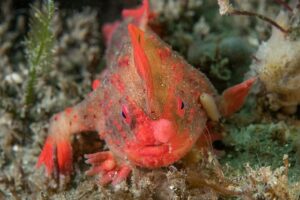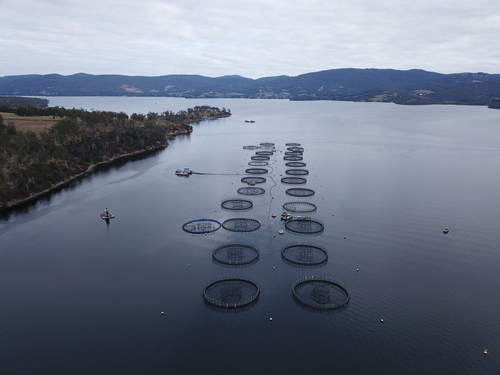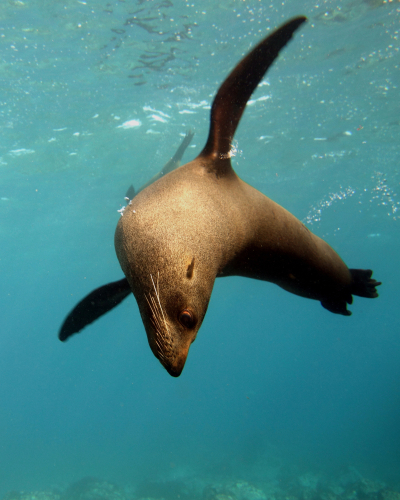The issue
Tasmania’s beautiful coastal waters are home to some of our most distinctive wildlife —like the Maugean Skate and Spotted Handfish. But the fragile marine ecosystems they call home are under threat from industrial salmon farming.
Instead of placing clear limits on pollution from salmon farming, the Tasmanian Government is planning to wind back weak marine protections even further.
These new rules might work for the salmon industry in the short term, but they don’t work for nature. EDO is calling for sensible, science-based regulations to protect Tasmania’s precious coastal ecosystems.

Background
Industrial salmon farming is having serious impacts on Tasmania’s sensitive marine habitats and threatened species. What started as small, low-tech industry has exploded in the past two decades, however the regulation of salmon farming is not keeping pace with the industry’s impact on the environment and Tasmania’s precious marine life.
Commercial salmon farming relies on highly industrialised processes to achieve scale. Atlantic salmon, a non-native species, is farmed in sea cages along Tasmania’s estuaries, inshore channels and harbours. The cages are open to the ocean and waste from the farms wash into the surrounding water. Salmon smolt are raised in hatcheries on some of Tasmania’s most pristine rivers. In many cases, hatchery waste is released directly back into the rivers with minimal treatment.
Evidence of environmental damage and animal welfare breaches, including the use of leaded bean bag shots and underwater explosives to deter fur seals, have plagued Tasmania’s salmon farming industry in recent years. Between 2017 and 2018, more than 1.3 million salmon died in Macquarie Harbour due to overstocking, and dead zones were recorded on the sea floor due to low oxygen levels.
Yet despite these impacts and the calls of scientists, policy experts and the wider community for stronger industry regulation, the Tasmanian Government is planning to wind back already inadequate marine protections even further.
EDO is highly concerned that the new rules the government plans to bring in will weaken protections for Tasmania’s coastal waterways, their ecosystems and endangered marine life.

Sign up to receive the latest news and legal updates from the Environmental Defenders Office
How do the new rules fail our marine ecosystems?
Below are some of the ways the proposed regulations fail Tasmania’s marine environment. Download EDO’s Recommendations for the Draft Environmental Standards for Marine Finfish Farming for further information.
Issue of escaped salmon ignored
The new rules don’t address the issue of farmed salmon escaping from their cages and damaging local ecosystems. In 2020, an estimated 50,000 Atlantic salmon escaped when an electrical fire damaged a Huon Aquaculture fish pen. As salmon farming moves to rougher offshore waters, the risk of fish escapes increases.
Failure to set limits on salmon pollution and numbers
The new rules don’t set clear limits on the amount of pollution that can be released by salmon farms or the number of salmon that can be farmed in fragile coastal waters. Bigger salmon farms mean more pollution from nitrogen and other nutrients that choke sensitive marine ecosystems. Pollution from salmon farming is one of the key threats pushing the ancient Maugean Skate towards extinction.
Pollution legalised up to 135 meters
Alarmingly, the government proposes giving finfish farmers an extra 100m of permitted “significant” environmental impacts around their farms. This means the salmon industry would legally be permitted to pollute the sea floor up to 135m from the edge of their fish farming site, whereas these impacts are currently limited to 35m.
Lack of transparency
The new rules to not require the public release of monitoring data of salmon farming or information about environmental management decisions made by the EPA Board. Publicly available data and information relating to companies and individual fish farm operations are essential for understanding the health of our waterways and for the sustainable management of marine resources. To be transparent and accountable, the new rules should require the timely public release of information relating to the finfish farming industry, including biomass and pollution caps, fish escapes, disease, mortalities, effluent, antibiotic use, seabed changes, and marine debris from operations.
Flimsy and discretionary monitoring requirements
The proposed rules give the industry too much say in environmental monitoring standards, and they don’t set clear thresholds for negative environmental impacts that would trigger intervention. The proposed rules would also give regulators too much discretion. The government is proposing to regulate “significant impacts” on the sea floor, but these are not clearly defined. That lack of clarity will potentially allow industry to decide which environmental impacts it reports to the EPA. In any case, using “significant impact” as the benchmark sets the standard too low. Action must be required before substantial and potentially irreversible damage occurs.
What’s at stake?
World Heritage area impacts
Macquarie Harbour is a unique and sensitive waterway adjacent to a World Heritage Area. In 2018, overstocking of salmon farming leases in Macquarie Harbour led to the deaths of more than one million salmon in just six months. Marine dead zones were recorded which spread as far as the Wilderness World Heritage Area.
Risks of extinction to threatened species
Tasmanian waters are home to the Spotted Handfish, Australia’s most endangered fish species with a population of around 80, and the Maugean Skate. Both are listed by the Federal Government as a priority endangered species. Salmon farms in Macquarie Harbour pose a serious extinction risk to the Maugean Skate, the world’s rarest skate which is only found only in that area.
Protected fur seals not safe from cruel control methods
Salmon farmers are using brutal controls methods to deter fur seals from fish farming operations. Under Tasmanian laws, salmon farmers are allowed to use underwater explosives and shoot fur seals with plastic shells containing lead shot, called bean bag rounds.
A right-to-information request revealed seals are being killed by entanglement with fish cages, boat strikes and sedation, on top of the use of seal crackers and bean bag shots.

Biodiversity loss and disturbance in marine ecosystems
Salmon farms let faeces and food waste fall directly into the ocean below. The build-up excess nutrients, such as nitrogen and phosphorus, from fish waste and uneaten feed in surrounding waters can destroy marine ecosystems. It can result in eutrophication — the concentration of nutrients in a body of water — which can cause harmful algal blooms. These blooms can reduce oxygen levels in the water, leading to fish kills and other negative impacts on the local ecosystem. The use of chemicals such as antibiotics can leach into the surrounding waters and harm other aquatic organisms, including fish, shellfish, and other marine species.
Our recommendations
EDO makes five key recommendations for protecting Tasmania’s precious coastal ecosystems from the impacts of industrial salmon farming:
- Reinstate the moratorium on new salmon leases, until issues with our environmental laws have been addressed. This must mean no new leases, no increases of stocking limits and no expansion of current leases.
- Minimise the environmental impact by putting clear caps on pollution and biomass (numbers of fish per farm), based on the best available science and precautionary principle, and revoking salmon farming leases in shallow, low-flush bays and estuaries.
- Community voice in marine planning decisions through third-party comment and appeal rights for environmental licences, and no special rules for salmon farming under our environmental laws.
- Protect our most precious resource. Clear water quality objectives must be published for both fresh and marine waters, consistent with the State Policy on Water Quality Management.
- Reform Tasmania’s marine laws. Tasmanian Government to put in place holistic marine laws which provide for planning and ecosystem-based management, and recognition of Tasmanian Aboriginal custodianship and fishing and cultural rights.
Share this page using the links below





